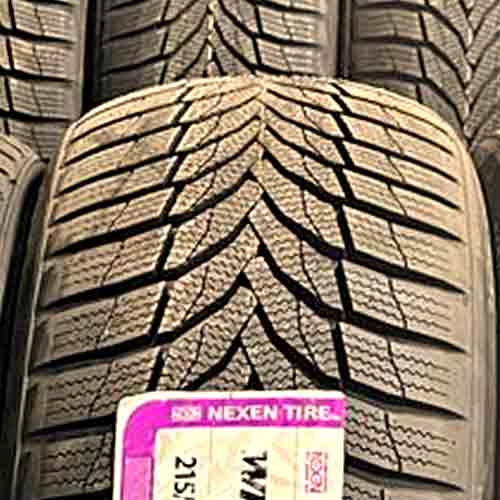Nexen WinGuard Sport 2, known for its superior snow traction, and Nexen Winspike, celebrated for its impressive performance on icy roads, are set to compete. Who will reign supreme in this winter tire showdown? Let’s find out!

Table of Contents
Key Takeaway
The Nexen Winguard Sport 2 takes the lead when it comes to:
- Wet Traction: Showcasing superior grip with its better siping design. Moreover, it exhibits impressive hydroplaning resistance owing to its well-interconnected grooves too.
- Snow Performance: The Winguard’s design ensures better snow-to-snow contact, excelling at displacing heavy snow. This design aids in forward progression by pushing snow backward during rotation, making it a preferable choice for snowy terrains.
- Comfort Levels and Tread Life: The Winguard offers a quieter ride due to its smaller tread voids. Its comfort performance stands out thanks to its superior shock absorption abilities, resulting from a softer rubber and greater tread depth. In terms of tread life, it promises longevity because of its closely spaced lugs and greater tread depth.
On the other side, the Nexen WinSpike shines in the following areas:
- Dry Traction: Particularly in directional grip, the WinSpike has a continuous central rib, ensuring superior braking distances and unbroken contact with the road.
- Handling: Though WinGuard has better grip, the WinSpike’s lighter construction gives it an edge in handling performance, resulting in faster lap times and better communication properties in steering.
- Ice Performance: The WinSpike consistently outperforms in icy conditions, presenting shorter braking distances and exceptional acceleration, attributed to its lighter weight and the added feature of stud-able lugs.
Also note that, both tires offer similar fuel economy, where they perform comparably, with neither standing out as significantly better than the other.
Wet Traction
When it comes to the wet traction of a tire, two key facets come into play: the tread design and the rubber compound. These components largely determine the tire’s grip and its resistance to hydroplaning. Let’s delve into each of these characteristics.
Wet Grip
While both tires are adorned with ample siping and flexible tread rubber, the Nexen Winguard Sport 2 distinctly outperforms when it comes to grip.

This tire is equipped with a dual siping design, exhibiting a varied mix of rectilinear and interlocking sipes.
As you can see the linear longitudinal slits, with the wavelike siping pattern, throughout the tread.
For those unfamiliar with the term, sipes work by drawing in water particles, thereby allowing the biters to grip onto the somewhat dried surface, with dual siping designs offering superior performance.
Moreover, see how the shoulders and central lugs have multiple angle orientations when it comes to siping.
These basically provide grip in all directions, meaning, it can be used to explain why the tire offers better directional and lateral wet grip in comparison.
Moreover, the tire also has one another advantage too, its superior hydroplaning resistance. Let me explain this in the next section.

Hydroplaning resistance
Hydroplaning transpires when water prevents the tread from making proper contact with the road.
This phenomenon can cause the tire to slightly lift off the surface, leading to a complete loss of traction, which is, needless to say, a hazardous situation indeed.
Now this resistance depends on grooves ability to throw water out.
And among the two, the Nexen Wnspike although offers wider grooves, especially when it comes to outer circumferential channels, the Winguard is still better in overall hydroplaning resistance, as seen by its greater float speeds.
So why is that?
Well, the answer lies in the fact that the WinGuard offers better inter-connectivity of its grooves, plus a more streamlined directional pattern.
See how lateral slits join up with the V shaped grooves. These basically provide this tire with faster water evacuation properties.
Moreover, the tire also has the advantage of greater tread depth, and with that more volume of water goes out at a given time.
So overall wet performance is superior on Nexen Winguard Sport 2.
Dry Traction
Dry traction comprises two aspects: directional grip and handling. Let’s explore these individually.
Directional Grip
Dry grip primarily depends on the central tread area, as it forms the majority of the contact with the ground. In this regard, the Nexen Winspike reigns supreme.
This tire features a continuous central rib, ensuring unbroken contact between the tire and the road, which results in superior braking distances, a key measure of directional grip.
I mean sure, it more voided up with its outer circumferential grooves, but its central area is still more packed up, and that allows it to brake quicker.
Nexen Winguard Sport 2 on the other hand, although is not voided up, lacks with its greater weight. This is because it creates greater momentum, which is not easier to stop, relatively.
So overall WinGuard is lacking to its counterpart, when it comes to directional or straight line grip.
Handling
The tire’s lateral traction or cornering capabilities hinge largely on its shoulder lugs. Two factors are considered here: how well the lugs connect with the ground as the tire turns, and the extent to which the lugs bend during this maneuver.
In other words, for optimal handling, you need lateral grip and superb/clear feedback from your wheels.
Now the WinGuard excels in terms of grip, and it makes sense, looking at its more packed up shoulders, but overall handling performance is still better on its counterpart.
This has to do with weight.
The Nexen WinSpike with its lighter construction, basically causes its lugs to stay more composed, and that offers better communication properties in terms of its steering.
That’s why overall the Winspike takes the lead, as seen by it’s faster overall handling lap times.
Snow Performance
Both tires exhibit remarkable performance in fluffy snow. And they both have great features contributing to that.
Both of them offer well engineered voids, primarily formed by in-groove notches that trap snow particles, thereby enhancing snow-to-snow contact. The trapped snow forms the contact patch with the ground as the tire rotates, improving traction, as snow sticks better to itself than to rubber.
Though still, the WinGuard takes the lead here, where it’s greater relative weight, putting down more pressure on the lugs, provide better snow to snow contact.
And in terms of acceleration, the Nexen Sport 2 with its streamlined sweeping V-shaped lugs excel at displacing heavy snow, aiding forward progression by pushing the snow backwards during rotation, much in line with Newton’s third law.
On the other hand, the WinSpike comes out with longer braking distances and handling times on snowy terrains, and that can be attributed to its less efficient in-groove notches, which fail to offer ample snow-to-snow contact.
Moreover, the absence of sweeping lugs further impairs its performance by eliminating the plowing effect.
So overall, its a win for WinGuard.
Tread Life
Tread longevity is substantially influenced by rolling resistance, a direct byproduct of the tire’s weight and rubber composition.
Now even though the Nexen Winguard is a heavier tire, and technically, it should put more pressure on the lugs, as they rub against the surface.
The tire still wears down slower, due to two main things.
One, it’s lugs aren’t spaced apart as much, especially towards shoulders, and so each of the tread blocks, still ends up getting less weight on them.
Moreover, its greater tread depth takes longer to reach down.
So in terms of tread longevity, WinSpike is lacking behind its rival here.
Ice Performance
When navigating icy terrains, the Nexen WinSpike steals the spotlight, consistently delivering shorter braking distances and exhibiting superior acceleration.
This can be attributed to its lighter weight, creating less momentum, which is easier to stop.
And that directly affects the handling, since entering the corner, requires drivers to slow down.
Moreover, the tire also has the additional advantage of stud-able lugs, missing in the WinGuard.
So overall, WinSpike ends up getting more scores, in terms of ice performance.
Comfort Levels
Tire comfort is largely determined by factors such as road noise and vibration absorption. These attributes are shaped by the tire’s construction, the materials used, tread pattern, and sidewall design, which ultimately determine the smoothness of the ride, especially during cornering.
Noise, essentially the result of air particles colliding with the tread walls, tends to increase with a voided tread. Hence, with its smaller tread voids, the Nexen Winguard Sport 2 leads in this department, offering a quieter ride.
Moreover, the tire also offers better shock absorption abilities too, since it has a softer rubber, followed by greater tread depth on average. Meaning, the road vibrations get better cushioned, with this tire.
So overall comfort performance is better on WinGuard in comparison to WinSpike.
Fuel Economy
The fuel efficiency of tires is closely tied to their traction and structural weight, the two areas which can be used to explain, why both tires offers similar results here.
In terms of WinGuard the tire’s relatively larger weight should result in additional lug bending during cornering, braking, or accelerating, leading to extra energy expenditure, but it gives out just as great of a fuel consumption like any other average winter tire, including its rival here.
This is because there’s more rubber area, which distributes that large weight in a way, that each lug ends up getting less overall weight.
On the contrary, the WinSpike is lighter, but is more voided up, so the opposite is happening here.
So moving from one tire to another, you would not see any difference in fuel economy.
To Conclude
Both tires have their pros and cons.
The Nexen Winguard Sport 2 emerges better when it comes to wet performance, where it’s tread is more biting, and its grooves offer better resistance to hydroplaning.
Moreover, when it comes to snowy terrains, the tire’s design, adept at displacing heavy snow and ensuring optimum snow-to-snow contact, becomes a favorite.
And it also promises a smoother ride experience with its smaller tread voids and excellent shock absorption from a softer rubber compound.
And although its a softer rubber, its greater tread depth still allows it to have more tread life.
On the other hand, the Nexen WinSpike dominates in dry traction, handling, and ice performance.
Its continuous central rib promises stellar directional grip, and its lightweight nature enhances handling capabilities, delivering faster lap times and more precise steering feedback.
Furthermore, its performance on icy terrains is also superior, with its faster braking and acceleration results, thanks to its lightweight design. Moreover, its ice traction is improvable too, as its lugs are stud-able unlike its counterpart.
P.S. Both tires have similar fuel economy.